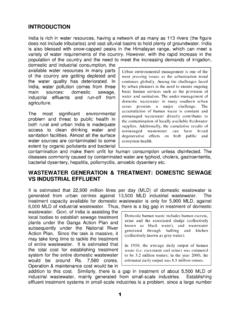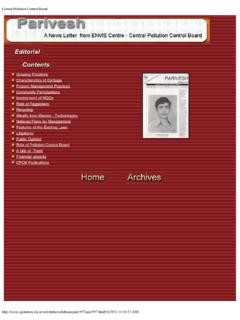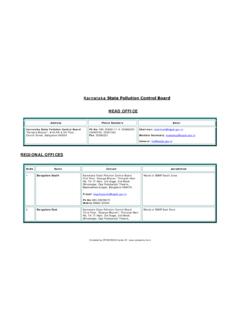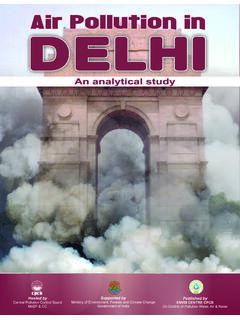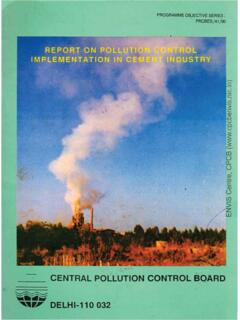Transcription of 1.0 INTRODUCTION are basically derived from …
1 1 INTRODUCTION Gasoline (Motor Spirit/MS) and Diesel (High Speed Diesel/HSD) are the major transport fuels in India. Adulteration of these transport fuels at the point of sale and during transportation has become an acute problem in the country. Transport fuels are often adulterated with other cheaper products or byproduct or waste hydrocarbon stream for monetary gains. For example, gasoline (petrol) is believed to be widely adulterated with naphtha, natural gas liquids, kerosene, waste solvents, byproduct petroleum stream, etc. With large number of adulterants available in the market, both indigenous and imported, the magnitude of the problem of fuel adulteration has grown into alarming proportions in the past few years.
2 The Motor Spirit and High Speed Diesel (Regulation of Supply and Distribution and Prevention of Malpractices) Order, 1998, defines adulteration as the INTRODUCTION of a foreign substance into motor spirit / high speed diesel, illegally or unauthorized with the result that the product does not conform to the requirements and specifications of the product. The foreign substances are called adulterants which when introduced alter and degrade the quality of the base transport fuels. CONVENTIONAL TRANSPORT FUELS (GASOLINE/DIESEL) Since the birth of automotives in the 19th century, diesel and gasoline are used as the primary source of energy for the vehicles, though many alternate fuels like CNG, LPG, alcohol, dimethylether, biodiesel, methanol, etc. are emerging in the market.
3 The conventional fuels are basically derived from crude oil, where crude oil is fractioned by continuous distillation into several fractions: Petrol (gasoline), kerosene (kerosene, paraffin oil), gas oil (heavy oil), vacuum gas oil, naphtha, lubricating oil and residue. These fractions are further processed through conversion, reforming and treatment processes to increase the yields and adjust the chemical composition of transport fuels and to remove the trace impurities. Finally, several streams are blended to produce transport fuels with the desired specifications. The composition of crude oil varies with the locality of occurrence, but all contains alkanes (straight and branched chain from about C1 to C40), cycloalkanes or napthenes, and aromatic hydrocarbons.
4 The low boiling fraction of almost all petroleum products are composed of alkanes; it is the composition of the higher boiling fraction, which differ according to the source of the petroleum. In addition to hydrocarbons, there are also present compounds containing oxygen, nitrogen, sulphur and metallic constituents. Codes, standards or specifications for the gasoline and diesel have been laid down in different countries. National or other legally enforceable specifications represent the minimum quality that must be supplied and it is implicit that engine designers should ensure that their vehicles will run satisfactorily on such a quality of fuel. In India, the Bureau of Indian Standards (BIS) notifies the requisite specifications for petrol and diesel.
5 Annexure I & II show BIS specifications for diesel & gasoline that are being implemented all over the country except in four metros, while in four metro cities Bharat stage-II fuel specifications are implemented. 2 COMMON FORMS OF FUEL ADULTERATION & POTENTIAL ADULTERANTS Blending or mixing of adulterants into the base transport fuels exists in various forms and both the type and quantity of adulterants vary from place to place. Moreover, profitability, availability and blendability are the prominent factors governing the choice of adulterants. Specific types of adulteration may be broadly classified as follows: Blending relatively small amount of distillate fuels like diesel or kerosene into automotive gasoline. Blending variable amount (as much as 30%) of the gasoline boiling range hydrocarbons such as industrial solvents into automotive gasoline.
6 Blending small amounts of spent waste industrial solvent such as used lubricants, which would be costly to dispose of in an environmentally approved manner-into gasoline and diesel. Blending kerosene into diesel, often as much as 20-30 percent. Blending small amount of heavier fuel oils into diesel. There are several petroleum products in our country or abroad, which are close substitutes of petrol (Motor Spirit or MS) and high-speed diesel (HSD), and are available at considerably lower prices. The consequence is that these products are widely used as adulterants. Some of the possible adulterants available in Indian markets are listed in Table-1 & 2. Table-1: Potential Adulterants for Gasoline (MS) SL. Solvent/Chemical Source Basic Cost (Rs.)
7 KL/MT Market Price (Rs.)* 1 Naphtha Refineries 14950 NA 2 SBP BPCL 13500+32% Exise+ST 20/lt 3 GAIL Solvents Bijalpur 12000+32% Exise+ST 17-19/lt 4 GAIL Solvents Pata 12000+32% Exise+ST 16-18/lt 5 Pentane GAIL 10000+16% Exise+ST 14-16/lt 6 Cixon IPCL 12000 NA 7 Solvent-90 IOC 26400 30-32/lt 8 Hexane Refineries 13500+32% Exise+ST 20-24/lt 9 Resol Reliance 11000 NA 10 Raffinate/Slop Refineries NA NA 11 C6-C9 Raffinate Petrochemicals NA NA 12 Naphtha/NGL GAIL/ONGC 13760 NA 13 PDS Kerosene Govt. 5000 7000/KL 14 Free Kerosene Parallel Marketers 14500 NA 15 MTO Refineries 16588 20-21/lt 16 Pyrolysis Gasoline Naptha NA NA 3 Crack 17 Oxygenates Refineries 15000 NA 18 Food grd. Hexane Refineries NA NA 19 Benzene Koyali +32% Exise+ST 27-29/lt 20 Toluene Koyali 28-30/lt *-Prevailing price (Approx.) in Delhi & Mumbai as on November 2000.
8 Source: Report of MoPNG Task Force to examine the use of solvent, raffinate and slop in automobile fuel. Table-2: Potential Adulterants for Diesel (HSD) SL. Solvent/Chemical Source Basic Cost (Rs.) KL/MT Market Price (Rs.)* 1 Aromex Digboi 15254+ Excise+ST 22/lt 2 Iomex NA NA NA 3 C9 Raffinate Ptrochmcls 10000 NA 4 MTO Refineries 12560 20-21/lt 5 PDS Kerosene Govt. 5000 7000/KL 6 Free Kerosene Parallel Marketers 14500 NA *-Prevailing price (Approx.) in Delhi & Mumbai as on November 2000. Source: Report of MoPNG Task Force to examine the use of solvent, raffinate and slop in automobile fuel. CAUSES OF FUEL ADULTERATION Financial incentives arising from differential taxes are generally the primary cause of fuel adulteration. In South Asia, gasoline carries a much higher tax than diesel, which in turn is taxed more than kerosene.
9 Industrial solvents and recycled lubricants are other materials with little or no tax. Adulteration of gasoline & diesel is indulged primarily due to the significant price difference between these products and the adulterant. Various estimates have been made of the extent of financial loss to the national exchequer and the oil companies as a result of diversion of PDS kerosene, use of off-spec, low value hydrocarbons mixed with petrol/diesel, evasion of sales tax, etc. There have been several independent studies conducted by private agency vis- -vis the quality of petrol and diesel that gets dished out from the outlets to the ultimate consumer. A study by the Tata Consultancy Services concluded that more than 30% of Kerosene distribution intended for household consumption through PDS outlets flowed back to industry in one form or the other.
10 Most developing country governments have not yet established a monitoring regime and system of fines that can act as a strong deterrent to fuel adulteration. There are number of reasons for this, including poor governance, a lack of political will, lack of public awareness, weak regulatory agencies and a shortage or even 4 absence of technical staff & equipment for designing and conducting monitoring. Given these limitations, identifying and dealing with this abuse will require addressing problems on multiple fronts. The primary factors encouraging the practice of adulteration are the following: Existence of differential tax levels amongst the base fuels, intermediate products and byproducts. The adulterants being taxed lower than the base fuels give monetary benefits when mixed with replacing a proportion of the base fuels.


